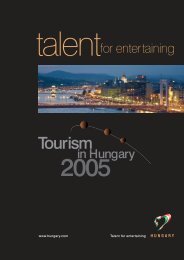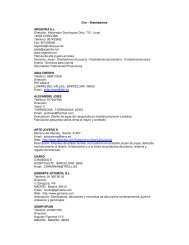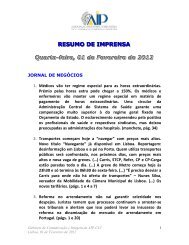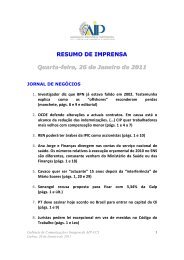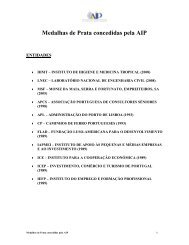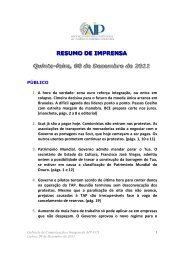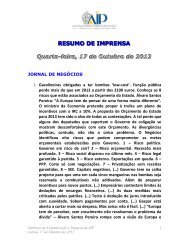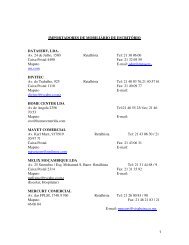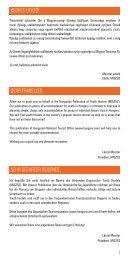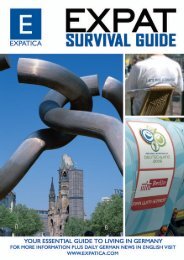front cover.qxd 09/02/2005 14:26 Page 1 - AIP
front cover.qxd 09/02/2005 14:26 Page 1 - AIP
front cover.qxd 09/02/2005 14:26 Page 1 - AIP
You also want an ePaper? Increase the reach of your titles
YUMPU automatically turns print PDFs into web optimized ePapers that Google loves.
es-transport.<strong>qxd</strong> <strong>09</strong>/<strong>02</strong>/<strong>2005</strong> 13:47 <strong>Page</strong> 44<br />
TRANSPORT<br />
44<br />
Public Transport<br />
Spain has one of the most highly efficient public transport system in Europe.<br />
Here is a basic guide to getting around on its trains, planes, buses and taxis.<br />
PLANES<br />
Spain's national airline is Iberia<br />
(www.iberia.es, tel. 9<strong>02</strong> 400 500), which<br />
operates international and national flights.<br />
Domestic flights may be cheaper with<br />
budget airlines Spanair (www.spanair.es,<br />
tel. 9<strong>02</strong> 131 415) or Air Europa (www.aireuropa.com,<br />
tel. 9<strong>02</strong> 40 15 01).<br />
TRAINS<br />
RENFE (www.renfe.es, tel. 9<strong>02</strong> 240 2<strong>02</strong>)<br />
operates the Spanish national train network.<br />
Smaller towns are served by regional<br />
networks such as FFCC in Catalunya.<br />
The high speed train - AVE - service is<br />
constantly being improved and extended<br />
considerably so that by 2007 all provincial<br />
capitals will be within a four-hour journey<br />
of Madrid and all provinces within six<br />
and a half hours from Barcelona. A full<br />
refund is offered if an AVE train arrives<br />
more than five minutes late at its destination.<br />
On any route you will find a variety<br />
of trains whose travel time to your destination<br />
can vary enormously. Make sure<br />
you realise this before you board, as you<br />
may find yourself on a slow one which<br />
stops at every station en route.<br />
Fares are cheap - about €0.60 per 10km for<br />
second class, €1 per 10km for first class -<br />
though they vary wildly according to the<br />
train's speed and comfort. Talgo trains are<br />
long-distance trains, though slower than<br />
the AVE, sometimes with sleepers (cochescama)<br />
for overnight journeys. The Talgo<br />
TEE operates international routes.<br />
Intercity (IC) trains are air-conditioned<br />
and fast, while Electrotren (ELT) and Tren<br />
Electrico Regional (TER) are slightly slower<br />
than the Talgo.<br />
Suburban commuter trains (cercanías) stop<br />
at all stations. A regional express or<br />
interurbano is a second class, air-condi-<br />
tioned diesel train and an exprés is a slow<br />
night train, usually with sleeping cars. A<br />
rápido is a daytime version of the exprés,<br />
but neither are particularly fast.<br />
BUYING TRAIN TICKETS<br />
Buying tickets is always confusing, given<br />
the range of trains, routes and fares on<br />
offer - and the ticket office clerk may not<br />
offer you, or know about, the cheapest<br />
options so make sure you ask.<br />
Fares for long-distance and high-speed<br />
trains are published in leaflets available<br />
from stations and RENFE offices and all<br />
fare information is available on the<br />
RENFE website (www.renfe.es). Children<br />
under four travel free and those aged<br />
between 4 and 12 travel for half price.<br />
You can buy tickets at station ticket windows<br />
(taquillas de billetes), from machines<br />
(máquinas de billetes), at RENFE offices and<br />
RENFE appointed travel agents or online.<br />
For the latter, however, you will need a<br />
password which requires calling RENFE<br />
(tel. 9<strong>02</strong>-157 507).<br />
RENFE also provides a telephone booking<br />
service (tel. 9<strong>02</strong>-240 2<strong>02</strong>) open from 5am to<br />
11.50pm and tickets can be delivered to<br />
addresses in Barcelona, Madrid, Seville<br />
and Valencia. Otherwise you have to collect<br />
your tickets yourself directly from a<br />
train station.<br />
There are two classes on most long-distance<br />
trains: first class (primera clase,<br />
shown as 1ª) and second class (segunda<br />
clase, shown as 2ª). AVE trains usually<br />
have three fare classes: turista (T-tourist),<br />
preferente (P-business) and club (C-first)<br />
and some trains such as IC and TEE international<br />
trains are first class only. Avoid<br />
travelling on public holidays and long<br />
weekends (puentes) as the trains will be<br />
fully packed.<br />
SPAIN EXPAT SURVIVAL GUIDE WWW.EXPATICA.COM



